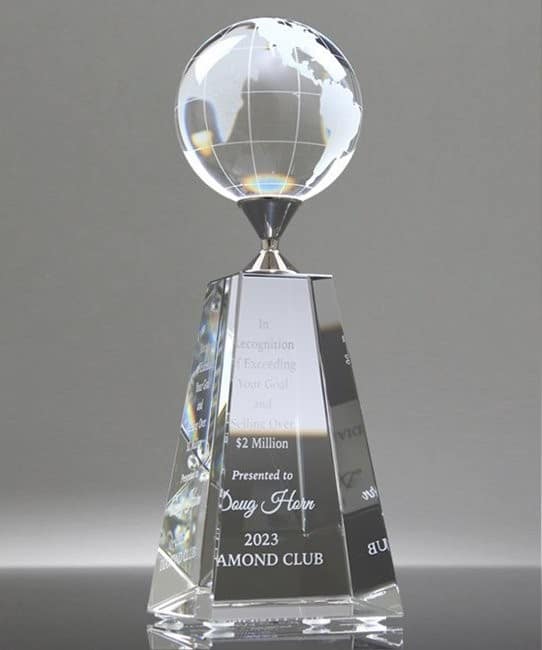Table of Contents
You might think that jade, optical, and art glass are pretty much the same type of product, but they are very different! They vary in their production processes, appearance, and applications.
These three types of glass are generally used for glass awards, so it is important to know how they differ. When buying a glass award, whether it’s for a special occasion or because you enjoy fine glasswork, knowing that there are different types of glass will help you make a better choice.
This article explains what is distinctive about jade, optical, and art glass. We will share their appearance, quality, best uses, and what differentiates them, so you can choose the right type of glass for your purchase.
Jade Glass
Jade glass is a glass with a green hue, primarily derived from its iron content; the green is soft and obvious, especially at the edges of a piece.
Jade glass is often used for inexpensive awards. Jade glass has a solid look, but not as much clarity as higher-grade glasses.
Key Points of Jade Glass
- A green hue is always present
- Color is more abundant at the edges than in the center of a piece
- Often heavier and thicker than clear glass
Pros
- Good choice for ordering large quantities or inexpensive awards
- Solid, sturdy, and durable
Cons
- Very slight color cast in jade glass
- Visibly less sparkle than high clarity glass
Optical Glass
Optical glass is clear and is about as close to crystal clear as one can get. It is clear and has no color distortion. Light can pass through without distortion.
This is a polished finish process that eliminates imperfections and creates a clean, bright piece.
Optical Glass Summary Points
- Clear and free of color.
- Polished to provide a high-quality appearance.
- Used for higher-end awards or fine decor.
Pros
- Clear appearance is appropriate for formal events.
- Good with engraving or 3D designs.
Cons
- Higher price than jade glass.
- Dirt shows easily: fingerprints, smudges.
Art Glass
Art glass focuses on design and color. It will have patterns, swirls, or strong forms. Every piece has the potential to have its own look due to the artistic process.
Traditionally, art glass is hand-crafted and aims for a distinct, unique look. Art glass is appropriate for awards when the purpose is less about the recognition and more about the look. Art glass is often dramatic, with bright colors, unique styling, or unique finishes.
Art Glass Summary Points
- Bright colors that include patterns or blends, colors, and/or swirls.
- Often shaped into creative dimensions.
- Every art glass has variations, although they may be small.
Pros
- Eye-catching, decorative.
- Independent characters on every piece.
Cons
- It can be heavy or irregular in shape.
- Usually, more expensive than jade glass.
Comparing Jade, Optical, and Art Glass
Here’s a quick reference chart of the three types of glass:
| Glass Type | Appearance | Cost Level | Best Use |
| Jade Glass | Green tint | Lower | Budget-friendly awards |
| Optical Glass | Crystal clear | Mid to high | Elegant, formal awards |
| Art Glass | Colored and patterned | High | Decorative display pieces |
Selecting the Right Glass for Awards
When selecting glass as awards, consider the surroundings where the awards will be displayed, the audience, and the message you want to convey. Jade glass works for an informal acknowledgment of achievement or for relatively large employee programs where cost matters. Optical glass will suit better for executive awards or milestones, or for events requiring a refined appearance.
Art glass is great for the creative industries or events where the design is just as important as the recognition. In a crowded hall or room, art glass will catch the attention of viewers even from a distance. While more expensive, art glass will make a statement that will convey the message of the importance of the recognition.
Carrying Care and Maintenance
Glass awards keep their appeal when cleaned and stored properly.
- Wipe off the dust with a soft, non-abrasive, lint-free cloth or similar material.
- Do not use a household cleaner that may scratch or dull the surface.
- Make sure to keep the glass award in a padded box or case when stored to avoid chips and cracks.
For art glass, be aware of direct sunlight when the colors are bright, as the color pigments can fade with time. With proper care, glass awards should retain clarity, color and polish for years.
Final Thoughts
Each glass serves a different purpose. Jade glass suits any informal awards. Optical glass works well when your intent is to show up in a formal way. Art glass is appropriate when the end product needs to have an emphasis on creative or decorative value, over recognition.
Quick Reminder
- Jade glass – Green tint, budget-friendly, solid look.
- Optical glass – Clear, polished, higher quality.
- Art glass – colorful, creative, unique or often hand-crafted.

